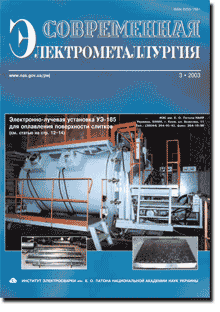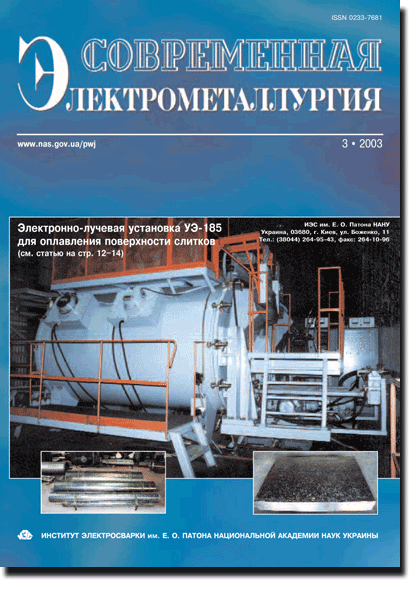

ELECTROSLAG TECHNOLOGY
Shevtsov V.L., Zhadkevich M.L., Majdannik V.Ya., Puzrin L.G. and Bogachenko A.G. Electroslag casting instead of forging in the production of high-pressure Christmas tree. P. 2
It is shown that billets of strong bodies of Christmas tree (CT), produced by ESC method, are superior by characteristics of ductility and toughness to the forged metal of CT bodies, which are manufactured by advanced foreign companies. It is established that ESC metal is also superior to the forged metal by the capability to undergo the plastic deformation in the conditions of a complex stressed state. The manufacture of high-pressure CT using ESC provides at minimum cost the highest its reliability during long-time service.
Medovar L.B. About mill rolls of future and electroslag technologies of their production. P. 7
State-of-the-art of production of mill rolls and tendency of its updating are discussed. It is shown that the mill rolls of the near future will be produced double-layered with a high-alloy working layer. Advantages of application of electroslag technologies in production of double-layer roll are considered.
ELECTRON BEAM PROCESSES
Trigub N.P., Zhuk G.V., Pikulin A.N., Kalinyuk A.N. and Kornijchuk V.D. Electron beam installation UE-185 for fusion of surface layer of ingots. P. 10
Equipment and elements of technology of fusion of a lateral surface of ingots of metals and alloys using electron beam are described. The offered design of the installation and mechanisms can realize fusion of both round and also slab ingots, the fusion of slab ingots being performed here for a single evacuation. Main technical parameters of the installation are given.
Ivanchenko N.V., Ustinov A.I. and Mokhort V.A. Thermodynamic analysis of evaporation of titanium and nickel from Ti-Ni melt in vacuum. P. 13
Taking into account the real values of thermodynamic properties of titanium and nickel in melt Ti-Ni, the characteristics of evaporation of components in vacuum are analyzed depending on their characteristics in melt and its temperature. It is shown that with increase in melt temperature of alloys of Ti-Ni system the coefficient of evaporation of nickel is greatly decreased. Chemical composition of molten pool in the range of temperatures from 1600 to 2200 K, required for attaining equiatomic composition of vapour phase, is calculated.
Lesnoj A.B. and Demchenko V.F. Modelling of hydrodynamics and mass exchange in electron beam remelting of titanium alloys. P. 17
Numerical modelling of processes of heat-mass exchange and hydrodynamics in solidification of ingots, produced by electron beam remelting, was made. The model is based of conjugate solution of equations of convective heat-mass transfer and hydrodynamics. The melt motion under the action of thermocapillary and gravitational forces occurring in the presence of gradients of temperatures and concentrations in metal pool is taken into consideration. Factors are analyzed and regularities of formation of chemical non-homogeneity in molten and solidifying metal are established.
PLASMA-ARC TECHNOLOGY
Shapovalov V.A., Yakusha V.V. and Gnizdylo A.N. Thermal field of large-sized refractory single crystals at combined plasma-induction heating. P. 22
Results of investigations of thermal fields of large single crystals of tungsten in the conditions of plasma-induction zone melting (PIZM) are presented. It is shown that the use of PIZM with fixed plasma-arc heat source allows growing single crystals of tungsten of diameter of not more than 70 mm. Scanning of plasma-arc heat source along the radius of crystal gives an opportunity to increase its diameter. The ratios of capacities of sources of plasma-arc and induction heating in growing large crystals are given.
VACUUM-ARC REMELTING
Lisienko V.G., Nasyjrov Ya.A., Klimov M.I., Altman P.S., Tashkinov A.Yu. and Goncharov A.E. Effect of ionization on voltage drop and frequency of droplet short-circuits in vacuum-arc remelting of high-alloy steels. P. 25
Experiment on vacuum arc remelting of 300 mm diameter electrode of alloy steel into 465 mm diameter mould was performed in the industrial conditions. Statistic model of changing arc voltage drop depending on the duration of relaxation period of ionization has been developed. The offered model can be used for optimum control of process of vacuum-arc remelting.
GENERAL PROBLEMS OF METALLURGY
Antonyuk S.L., Korol V.N., Molyar A.G., Romashko I.M., Zamkov V.N. and Topolsky V.F. Investigation of mechanical properties of forged semi-products of experimental titanium alloy T-110. P. 27
Strength characteristics of forged semi-products of experimental high-strength (a + b)-titanium alloys of Ti-Al-Mo-V-Nb-Fe-Zr system (T-110) after different conditions of forging and heat treatment are defined. Technological parameters of forging and heat treatment providing the required level of mechanical properties are developed. It is shown that the as-annealed forged alloy T-110 is not inferior by the level of strength to the forgings of industrial alloy VT22.
Burylyov B.P. and Mojsov L.P. Distribution of nitrogen between metal and slag. P. 31
Calculation equations are given for determination of nitrogen solubility in metal and slag melts. Thermodynamic properties of slag melts of CaO-SiO2-Al2O3 system are considered. Using the given equations the values of nitrogen solubility in metal and slag, and also the coefficient of nitrogen distribution between the slag and metal are established.
ELECTROMETALLURGY OF STEEL AND FERROALLOYS
Gasik M.I., Gasik M.M., Polyakov O.I. and Zubov V.L. Thermodynamic model of process of melting ferrosilicium in high-capacity ore thermal electric furnaces. P. 34
Thermodynamic model of process of producing ferrosilicium (silicon alloys) has been offered from the results of computer modelling equilibriums in Si-O-C-(H2, H2O) system, taking into account the effect of hydrogen and moisture in gas phase of high-temperature reaction zone of ore thermal electric furnace on thermodynamic stability of gas and condensed phases in carbon reduction of quartzite.
ENERGY AND RESOURCE SAVING
Lakomsky V.I. Mathematical model of calculation of specific electrical resistance of grained thermoanthracite depending on its fractional composition. P. 44
It is shown how it is possible to obtain analytical dependence of specific electrical resistance of bulk mass on internal specific resistance of material of solid body and fractional composition of bulk mixture by using conception of R.Holm about a real contact of two fragments of solid body.
(You are viewing the simplified file contents)
The cost of subscription/purchase order journals or individual articles
| Journal/Currency | Annual Set | 1 issue printed |
1 issue |
one article |
| TPWJ/USD | 384 $ | 32 $ | 26 $ | 13 $ |
| TPWJ/EUR | 348 € | 29 € | 24 € | 12 € |
| TPWJ/UAH | 7200 UAH | 600 UAH | 600 UAH | 280 UAH |
| AS/UAH | 1800 UAH | 300 UAH | 300 UAH | 150 UAH |
| AS/USD | 192 $ | 32 $ | 26 $ | 13 $ |
| AS/EUR | 180 € | 30 € | 25 € | 12 € |
| SEM/UAH | 1200 UAH | 300 UAH | 300 UAH | 150 UAH |
| SEM/USD | 128 $ | 32 $ | 26 $ | 13 $ |
| SEM/EUR | 120 € | 30 € | 25 € | 12 € |
| TDNK/UAH | 1200 UAH | 300 UAH | 300 UAH | 150 UAH |
| TDNK/USD | 128 $ | 32 $ | 26 $ | 13 $ |
| TDNK/EUR | 120 € | 30 € | 25 € | 15 € |
AS = «Automatic Welding» - 6 issues per year;
TPWJ = «PATON WELDING JOURNAL» - 12 issues per year;
SEM = «Electrometallurgy Today» - 4 issues per year;
TDNK = «Technical Diagnostics and Non-Destructive Testing» - 4 issues per year.





